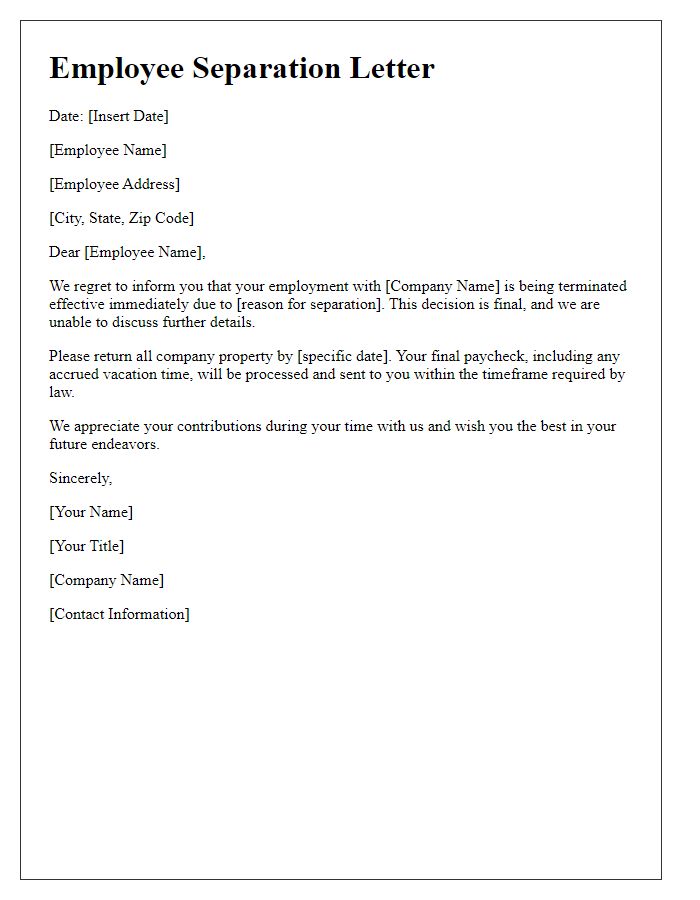When the time comes to let an employee go, crafting a clear and compassionate termination notice is crucial. It can be a daunting task, but it's important to approach the situation with sensitivity, ensuring that the message is both respectful and straightforward. A well-structured letter not only communicates the decision effectively but also helps to maintain a professional tone during a difficult moment. Curious about how to create such a letter? Read on for a helpful template and tips!

Clear Explanation of Termination Reason
Sudden employee termination typically occurs due to specific incidents such as gross misconduct, persistent underperformance, or violation of company policies. For instance, if an employee, John Smith, consistently fails to meet quarterly sales targets (less than 60% of the goal over three consecutive quarters) despite receiving multiple warnings, the rationale for termination gains clarity. Additionally, actions such as theft or harassment cases directly impact a firm's work environment, justifying immediate dismissal. Important factors in these situations include company policy adherence, documented performance reviews, and legal compliance, all integral to ensuring a fair process. This structured approach protects organizational integrity while addressing employee behavior.
Effective Termination Date
An effective termination notice must clearly communicate the discontinuation of employment with specific details regarding the separation. The termination date, typically marked by a date such as "October 30, 2023," highlights the last working day. Employees should be informed of the reasons for termination, which may relate to performance issues or company policy violations. Essential details, such as return of company property and final paycheck arrangements, enhance clarity. Additionally, addressing benefits, such as health insurance coverage through COBRA, ensures employees understand their rights and options post-termination.
Reference to Company Policies
Termination procedures often align with company policies to ensure a orderly transition and compliance with labor laws. An immediate termination can occur due to policy violations, such as breaches of conduct standards or unapproved absences. Company guidelines typically articulate the expected behavior of employees, which may include attendance requirements and adherence to ethical standards. The Human Resources Department plays a crucial role, ensuring that the process aligns with the Employee Handbook provisions, often providing documentation to substantiate the decision. A reference to relevant policies not only offers transparency but also safeguards the company against potential legal challenges related to wrongful termination.
Return of Company Property
The return of company property is a critical step following the sudden termination of an employee's contract. Company assets, including laptops, mobile phones, access cards, and confidential documents, must be collected promptly. Each item should be cataloged to ensure accountability, with a complete inventory list dated and signed by both the employer and the departing employee. Failure to return company property can lead to financial repercussions or legal actions, particularly concerning data protection laws concerning sensitive information. Proper documentation of the return process not only safeguards company assets but also serves as a protective measure for the organization against potential disputes.
Final Compensation Information
A sudden employee termination notice should clearly outline essential details about final compensation, severance pay, and any accrued benefits. In this formal communication, include the termination date, which in many instances could be immediate or effective within a few days. Specify final paycheck details, covering earned wages up to the termination date, plus any unused vacation days or paid time off (PTO) according to the company's policy, typically outlined in the employee handbook. If applicable, include information about severance packages, which may vary based on company policies and length of employment, providing a general overview of payout schedules. Furthermore, mention how health benefits will be affected, including eligibility for COBRA continuation coverage or similar plans, as mandated by the Employee Retirement Income Security Act of 1974 (ERISA). Highlight the importance of returning company property, including access cards and electronic devices, before the final separation. The notice should be succinct, clear, and devoid of any ambiguity to ensure that all parties understand the terms of the termination and the compensation process that follows.













Comments